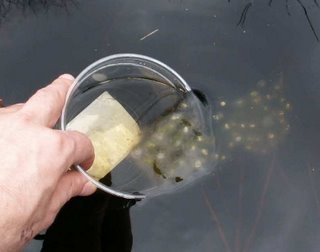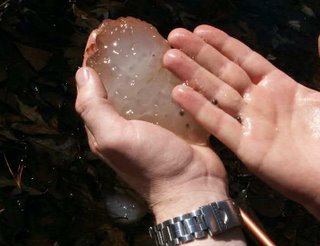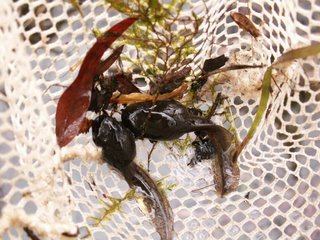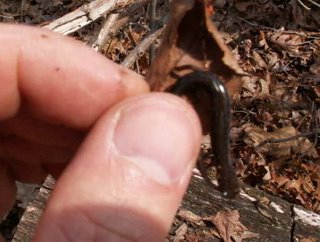Egg masses are kind of gross to look at. To prove that point, here are some photos of egg masses:
Wood frog (Rana sylvatica):

Spotted salamander (Ambystoma maculatum):

Tiger salamander (Ambystoma tigrinum):

I’ll point out here that the spotted and tiger salamanders are target species for me. I’ve never seen adults of either, and I’m pretty pissed off at myself for missing their respective breeding aggregations. Both come out in hordes on cold, rainy nights for a huge orgy (there’s no better word) of breeding and egg laying.
In New Jersey and Delaware the tiger salamanders tend to breed in December and January, while the spotted salamanders get it on in February and March. It was February that I learned that the tigers here breed in December and January, so I got to feel frustrated in retrospect. I knew darn well when the spotted salamanders were breeding (we only had so many rainy nights in March); I was out of town or otherwise occupied when they were doing their thing.
I’ve seen plenty of photographs of the breeding aggregations (the scientific term for an amphibian orgy), so I know what I was missing: hundreds or thousands of salamanders marching through meadows and forests, across roads and over hills to reach their little vernal pools in the woods. They then mill about in the water, the males dropping their spermatophores (little white balls o’sperm tethered to the bottom), and the females then picking them up with their cloacas and soon popping out gelatinous globes of clear eggs. It’s apparently quite an exciting thing to witness. I don’t have many plans that extend beyond the next few months, but it is a major goal of mine to catch them in the act next winter and spring.
It would be nice to see wood frogs too. I’ve caught plenty of the adults, but it would be cool to see them hopping about the frigid water and quacking to each other in an effort to hook up.
I went out to some Delmarva Bays in Delaware to see if I could catch the next breeders and maybe find some lingering salamanders under logs or artificial cover (a.k.a. trash). Those next breeders are all frogs: spring peepers (Pseudacris crucifer), New Jersey chorus frogs (Pseudacris triseriata kalmi), southern leopard frogs (Rana ultricularia), and pickerel frogs (Rana palustris).
I heard them all calling as I pulled on my hip-wader boots next to my car. I took my net in one hand, slung my camera around my neck, and marched off to the water.
Spring peepers are one of the most aptly named creatures on the planet. Every spring the males take up positions in low vegetation near water and start calling. They make a clear, high-pitched peep. You have heard spring peepers. You might not have known what they were when you heard them, but their choruses are one of the most common and distinctive sounds of spring just about anywhere in the eastern and central United States.
Chorus frogs make a different noise: kind of like a finger being pulled across the teeth of a comb, but maybe a little bit more musical than that. Pickerel frogs and southern leopard frogs both make a farting/snoring noise. The pickerel frogs do it in slower, longer notes; the southern leopard frogs make pretty much the same sound as a faster trill.
The Delmarva bay:

The spring peepers were calling from the bushes around the bay, while the chorus frogs seemed to be calling from the bushes growing out of the water, or, more specifically, out of the moss at the bases of these bushes.

The chorus frogs and peepers were calling from all around me as I waded out among the bushes. There were a few pickerel and leopard frogs calling from the edges, but the little guys ruled that pond on Saturday. They called in waves. I would hear a couple peeps or chorus frog calls, then a few more would answer, and soon they were all yelling at each other from all directions. Then they would stop for a couple minutes.
I picked out one of the chorus frogs calling near me. I slogged a few yards over to triangulate, and then I headed slowly towards the bush that the little guy had claimed for his stage.
He shut up. The others were still calling, so I think he saw or heard me. I froze. Soon they whole chorus ceased. I waited with my eyes fixed in his direction. Soon, a chorus frog across the pond couldn’t take the silence anymore and started singing again. That frog's rivals couldn’t let that go without a challenge, and the wave swept towards me. My frog forgot about me, started singing too, and I took a few more steps. I kept staring, trying to spot that inch-long troubadour as he inflated his throat to sing. After twenty minutes of this I had reached the bush, but my frog was keeping his mouth shut. I looked all around the bush, I pulled apart some of the moss to peek inside, and I stuck my net underneath and shook hard to see if I couldn’t knock him out of there, but either he was holding on really tight or he had fled.
Undeterred, I picked out another bush (stopped for some egg mass photos) and repeated. I did this for almost two hours, and I did not see a single chorus frog or spring peeper. I tried sweeping my net around a small, emergent tree. I caught these large tadpoles, but no frogs.

I hiked around for another hour after I gave up on the bay. I tried turning over logs, but the ground was almost uniformly dry, and the only critter I saw was this little leadback-phase redback salamander (Plethodon cinereus).

On the upside, this trip confirmed the existence of tiger salamanders and spotted salamanders in this pond; now it’s just a question of waiting a year and watching the forecasts.
I will try frog stalking again sooner, next time at night. If I understand correctly, the frogs come out into the open a little more when it’s dark out. A couple people with flashlights standing a few yards apart can each point their beam at the sound of one frog calling and pretty reliably catch it in the act at the crux of the beams.
I visited some trash piles in western Atlantic County, New Jersey that afternoon. I didn’t find much. There were more frogs calling from a vernal wetland, and I got a good shot of this fence lizard (Sceloporus undulatus hyacinthinus). I was looking under tires a few yards away, and I got the feeling it was wondering what the hell I was doing.

Conditions were cloudy and humid with some rain in the morning and partly cloudy in the afternoon. Temperatures were in the high 60s.
Totals (excluding egg masses):
1 redback salamander
1 fence lizard
? Spring peepers heard
? New Jersey chorus frogs heard
? Pickerel frogs heard
? Southern leopard frogs heard
No comments:
Post a Comment